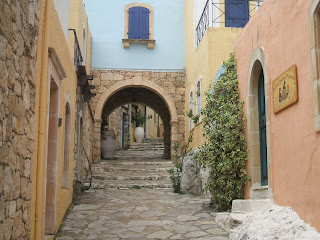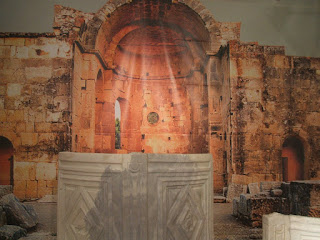
After two days in Athens, we began our Cretan adventure at Arolithos, a traditional Cretan village. We found Arolithos very pretty but very quiet and lonely, being way out in the country. Arolithos was literally divided between the sheep and the goats, on either side of the village.
 The next day we moved from the 'country' to the Captial City of Crete, Heraklion where we booked into the delightful Castello hotel. Right across from the hotel was one of many statues celebrating key Cretans who have liberate Crete from its numerous invaders.
The next day we moved from the 'country' to the Captial City of Crete, Heraklion where we booked into the delightful Castello hotel. Right across from the hotel was one of many statues celebrating key Cretans who have liberate Crete from its numerous invaders.



 The next day we moved from the 'country' to the Captial City of Crete, Heraklion where we booked into the delightful Castello hotel. Right across from the hotel was one of many statues celebrating key Cretans who have liberate Crete from its numerous invaders.
The next day we moved from the 'country' to the Captial City of Crete, Heraklion where we booked into the delightful Castello hotel. Right across from the hotel was one of many statues celebrating key Cretans who have liberate Crete from its numerous invaders.Crete is famous for its numerous archeological sites. In both the National Archeological Museum in Athens (left) and the Archeological Museum of Crete (right) are displayed beautiful ancient Cretan vases. Crete is the largest of the Greek islands at 8,336 km² (3,219 square miles) and the fifth largest island in the Mediterranean.
Our first Sunday in Crete started with heavy rain, requiring us to take a taxi to the 7am service at Hagios Tito/Titus Church where Titus' actual head is kept in the side chapel. The Hagios Tito service lasted 3 and 1/2 hours. For the first hour, there were more clergy and robed choir than congregation: about 8 including us. Time is no concern to Cretans. Every hour, more people wandered in, until three hours later the service was 80% full. Even the choir members wandered in and out over the three+ hour service.
There were no instruments. The two miked-singers/cantors who led the choir had excellent base voices. The congregation never sang. At the end of the service, any of the people who did not take communion were invited to receive a blessed piece of bread to eat on their way out. All the children took communion, plus many of the adults who felt spiritually connected that day.
The Greek Orthodox Archimandrite Makarios officially welcomed us to Crete and invited us to have coffee with him after the service. His English was excellent, so we had a great conversation. I was able to give him a copy of 'Battle for the Soul of Canada' as a gift which he seemed pleased to receive. As he is also a medical doctor, he gave us a gift of his book on Orthodox bioethics.
After Church, we went for lunch with one of the young Cretan couples. It was a great opportunity to learn more about Crete, and how to not butcher the modern Greek language. Quite understandably, Greek has changed a bit in two thousand years. For example, the 'eu' in Eucharist/Thank you is currently pronounced as an 'f' as in 'Efharista'.
Our first Sunday in Crete started with heavy rain, requiring us to take a taxi to the 7am service at Hagios Tito/Titus Church where Titus' actual head is kept in the side chapel. The Hagios Tito service lasted 3 and 1/2 hours. For the first hour, there were more clergy and robed choir than congregation: about 8 including us. Time is no concern to Cretans. Every hour, more people wandered in, until three hours later the service was 80% full. Even the choir members wandered in and out over the three+ hour service.
There were no instruments. The two miked-singers/cantors who led the choir had excellent base voices. The congregation never sang. At the end of the service, any of the people who did not take communion were invited to receive a blessed piece of bread to eat on their way out. All the children took communion, plus many of the adults who felt spiritually connected that day.
The Greek Orthodox Archimandrite Makarios officially welcomed us to Crete and invited us to have coffee with him after the service. His English was excellent, so we had a great conversation. I was able to give him a copy of 'Battle for the Soul of Canada' as a gift which he seemed pleased to receive. As he is also a medical doctor, he gave us a gift of his book on Orthodox bioethics.
After Church, we went for lunch with one of the young Cretan couples. It was a great opportunity to learn more about Crete, and how to not butcher the modern Greek language. Quite understandably, Greek has changed a bit in two thousand years. For example, the 'eu' in Eucharist/Thank you is currently pronounced as an 'f' as in 'Efharista'.

In the afternoon, we went by bus to the famous Knossos archeological palace, where the ancient Minoans had their headquarters. As the centre of the Minoan civilization (ca. 2600–1400 BC), Cretan culture was the oldest form of Greek and hence European civilization. It is not surprising that there are over 2,000 scholars and archeologists on Crete.

After that, we went to the Venetian Port at Heraklion where the wind on the windbreaker was so strong that it almost blew us off our feet. We can understand how Paul in Acts 27:10 warned the ship captain not to leave Crete because of the winter danger of shipwreck. Even today Cretans do not do much fishing in the winter.

On Monday we first went to the Hagios Minas Cathedral where we met three of their priests, including Fr. Methodius, the administrator for their Archdiocese in Crete. Every where we went, we were greeted with much hospitality and gifts about Titus, including a palm Sunday cross which the Eastern Orthodox are preparing for (being later than our western Easter).

A taxi driver Immanuel, who carries a Greek bible in his taxi, drove us to the Agaradou Monastry way up on a remote hill where we met the Abbot Irasmus who gave us a memorable tour of the monastry. Then we visited Fr. Makarios at their radio station where we had more food and hospitality.

A taxi driver Immanuel, who carries a Greek bible in his taxi, drove us to the Agaradou Monastry way up on a remote hill where we met the Abbot Irasmus who gave us a memorable tour of the monastry. Then we visited Fr. Makarios at their radio station where we had more food and hospitality.

Later that afternoon, we were fortunate to visit the National Museum of Crete, where we saw the stone pulpit from the original Hagios Tito Church in Gortyn/Gortyna. We also learned about the many times the Cretan people have been conquered, and yet how they reemerged after great persecution. All of their church buildings after the conquest of 1669 were closed, and converted to other purposes. Only 50 people in their main city of Heraklion (Chandax) were left after a continuous siege for twenty years, reportedly the longest siege in the history of the world.
The resilience and deep faith of the Cretan people is a lesson to others facing difficulties in life. My prayer for those reading this article is that we would show the same resilience and faithfulness when we face life’s disappointments.
Yours in Jesus Christ,
Yours in Jesus Christ,
Ed Hird+



1 comment:
Ed,
Thank you for the tour of Crete with your commentary and photos. Beautiful! Makes me want to pack a suitcase and do some travelling myself.
Kimberley Payne
www.kimberleypayne.com
Post a Comment